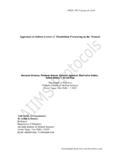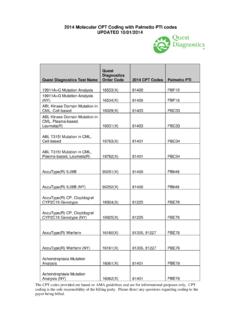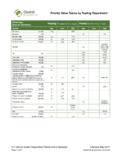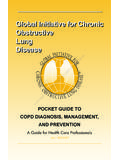Transcription of Intravenous augmentation treatment and lung ... - …
1 Published online May 28, 2015 (15)60860- 1 1 intravenous augmentation treatment and lung density in severe 1 antitrypsin defi ciency (RAPID): a randomised, double-blind, placebo-controlled trialKenneth R Chapman, Jonathan G W Burdon, Eeva Piitulainen, Robert A Sandhaus, Niels Seersholm, James M Stocks, Berend C Stoel, Liping Huang, Zhenling Yao, Jonathan M Edelman, Noel G McElvaney, on behalf of the RAPID Trial Study Group*SummaryBackground The effi cacy of 1 proteinase inhibitor (A1PI) augmentation treatment for 1 antitrypsin defi ciency has not been substantiated by a randomised, placebo-controlled trial. CT-measured lung density is a more sensitive measure of disease progression in 1 antitrypsin defi ciency emphysema than spirometry is, so we aimed to assess the effi cacy of augmentation treatment with this The RAPID study was a multicentre, double-blind, randomised, parallel-group, placebo-controlled trial of A1PI treatment in patients with 1 antitrypsin defi ciency.
2 We recruited eligible non-smokers (aged 18 65 years) in 28 international study centres in 13 countries if they had severe 1 antitrypsin defi ciency (serum concentration <11 M) with a forced expiratory volume in 1 s of 35 70% (predicted). We excluded patients if they had undergone, or were on the waiting list to undergo, lung transplantation, lobectomy, or lung volume-reduction surgery, or had selective IgA defi ciency. We randomly assigned patients (1:1; done by Accovion) using a computerised pseudorandom number generator (block size of four) with centre stratifi cation to receive A1PI intravenously 60 mg/kg per week or placebo for 24 months.
3 All patients and study investigators (including those assessing outcomes) were unaware of treatment allocation throughout the study. Primary endpoints were CT lung density at total lung capacity (TLC) and functional residual capacity (FRC) combined, and the two separately, at 0, 3, 12, 21, and 24 months, analysed by modifi ed intention to treat (patients needed at least one evaluable lung density measurement). This study is registered with , number NCT00261833. A 2-year open-label extension study was also completed (NCT00670007).Findings Between March 1, 2006, and Nov 3, 2010, we randomly allocated 93 (52%) patients A1PI and 87 (48%) placebo, analysing 92 in the A1PI group and 85 in the placebo group.
4 The annual rate of lung density loss at TLC and FRC combined did not diff er between groups (A1PI 1 50 g/L per year [SE 0 22]; placebo 2 12 g/L per year [0 24]; diff erence 0 62 g/L per year [95% CI 0 02 to 1 26], p=0 06). However, the annual rate of lung density loss at TLC alone was signifi cantly less in patients in the A1PI group ( 1 45 g/L per year [SE 0 23]) than in the placebo group ( 2 19 g/L per year [0 25]; diff erence 0 74 g/L per year [95% CI 0 06 1 42], p=0 03), but was not at FRC alone (A1PI 1 54 g/L per year [0 24]; placebo 2 02 g/L per year [0 26]; diff erence 0 48 g/L per year [ 0 22 to 1 18], p=0 18).
5 treatment -emergent adverse events were similar between groups, with 1298 occurring in 92 (99%) patients in the A1PI group and 1068 occuring in 86 (99%) in the placebo group. 71 severe treatment -emergent adverse events occurred in 25 (27%) patients in the A1PI group and 58 occurred in 27 (31%) in the placebo group. One treatment -emergent adverse event leading to withdrawal from the study occurred in one patient (1%) in the A1PI group and ten occurred in four (5%) in the placebo group. One death occurred in the A1PI group (respiratory failure) and three occurred in the placebo group (sepsis, pneumonia, and metastatic breast cancer).
6 Interpretation Measurement of lung density with CT at TLC alone provides evidence that purifi ed A1PI augmentation slows progression of emphysema, a fi nding that could not be substantiated by lung density measurement at FRC alone or by the two measurements combined. These fi ndings should prompt consideration of augmentation treatment to preserve lung parenchyma in individuals with emphysema secondary to severe 1 antitrypsin defi CSL defi ciency of 1 antitrypsin , fi rst described by Laurell and Eriksson1 in 1963, is associated with a strong tendency for development of emphysema, often, but not always, panlobular in character and basal in distribution.
7 This emphysema is thought to be the result of in-adequate neutralisation of naturally occurring proteases, such as neutrophil elastase, by 1 proteinase inhibitor (A1PI), which normally serves as a protease A1PI, purifi ed from pooled human plasma and given as an Intravenous infusion once a week at a dose of 60 mg/kg, increases and maintains A1PI serum concentrations at more than the accepted protective threshold of 11 M while producing measur able increases in the antielastase activity of the epithelial lining fl uid of the OnlineMay 28, 2015 (15)60860-1 See Online/ (15)60036-8*Members listed at end of paperAsthma and Airway Centre, University Health Network, Toronto Western Hospital, and Division of Respiratory Medicine, Department of Medicine, University of Toronto, Toronto, ON, Canada (Prof K R Chapman MD); St Vincent s Hospital, Fitzroy, Melbourne, VIC, Australia (J G W Burdon MD); Sk ne University Hospital, Lund University, Malm , Sweden (E Piitulainen MD); National Jewish Health, Denver, CO, USA (Prof R A Sandhaus MD); Gentofte Hospital, Hellerup, Denmark (N Seersholm MD); University of Texas Health Science Center at Tyler, Tyler, TX, USA (J M Stocks MD).
8 Division of Image Processing, Radiology, Leiden University Medical Center, Leiden, Netherlands (B C Stoel PhD); CSL Behring, King Of Prussia, PA, USA (Z Yao MD, J M Edelman MD, L Huang MD); and Beaumont Hospital, Royal College of Surgeons in Ireland, Dublin, Ireland (Prof N G McElvaney MD)Correspondence to:Prof Kenneth R Chapman, Asthma and Airway Centre, University Health Network, Toronto Western Hospital, Toronto, ON M5T 2S8, Published online May 28, 2015 (15)60860-1No randomised, placebo-controlled clinical trial has been able to substantiate that progression of emphysema is slowed by A1PI augmentation treatment as shown by established disease variables such as forced expiratory volume in 1 s (FEV1).
9 Such trials were not regarded as feasible when augmentation treatment was fi rst ,5 Changes in FEV1 take place slowly for many years, even in a rapidly progressive disease setting, so that several hundred patients would need to be randomised to augmentation treatment or placebo for 5 years to establish the eff ect of augmentation treatment on ,5 In a rare disease setting, to do such a trial was not thought possible on the basis of several considerations not just the absence of a suffi ciently large population of identifi ed patients available for study, but also the high costs of such a study and ethical concerns raised by extended treatment with placebo.
10 Since the introduction of augmentation treatment for clinical use in the USA, Germany, Canada, and other nations, fi ndings from observational and cohort studies have shown that the rate of FEV1 loss is slower in individuals who receive augmentation treatment than in those who do 8 The largest of these observational studies, the National Institutes of Health registry study,9 showed that augmentation treatment was associated with reduced mortality in the most severely obstructed patients. However, such non-randomised fi ndings can be confounded by other factors, such as diff erences in socioeconomic status and health-care-seeking behaviour between have sought more sensitive treatment endpoints than FEV1 that would make possible a defi nitive randomised, placebo-controlled trial in fewer patients for less time.






